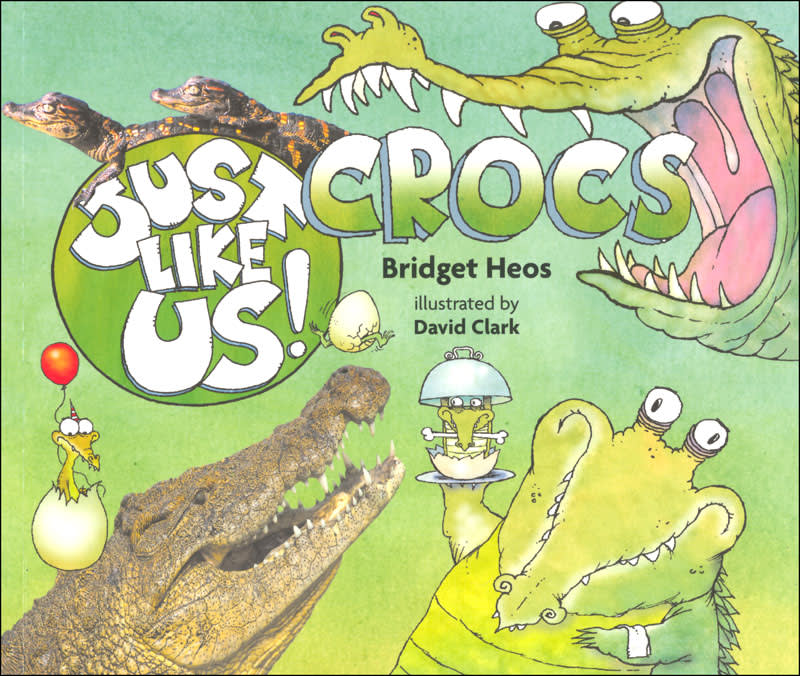- Bargain Items are brand-new products that have been dinged, dented, or scuffed, but are otherwise in usable condition.
- Bargain Items have limited inventory, and they are only reserved for you when checkout is completed.
- Bargain Items are non-returnable and non-refundable.
Just Like Us! Crocs
SKU
078715
ISBN
9780358003908
Grade PK-3
These icons are designed to help you quickly understand and learn important information about our products.
Teaching Method
Traditional
Teacher-centered curriculum commonly used in classrooms that may include a text, teacher manual, tests, etc.
Charlotte Mason
A methodology based on the work of a 19th century educator who maintained that children learn best from literature (Living Books), not textbooks.
Classical
A methodology based on the Latin Trivium (three stages of learning), including the grammar stage (memorization and facts), logic stage (critical thinking), and rhetoric stage (developing/defending ideas).
Unit Study
A thematic or topical approach centered around one topic that integrates multiple subject areas.
Montessori (Discovery)
A methodology based on the work of a 20th century educator that emphasizes student and sensory-driven discovery learning and real-life applications.
Other
Other methodologies
Religious Content
Secular
Contains content contrary to common Christian beliefs (i.e. evolution).
Neutral
Avoids religious or theoretical topics or presents multiple viewpoints without preference.
Christian/Religious
Faith-based or including instructional religious content.
Learning Modality
Auditory
Learns through listening, talking out loud or reading out loud.
Visual
Learns through seeing, prefers written instructions and visual materials.
Kinesthetic/Tactile (Hands-On)
Learns through moving, doing and touching.
Multi-Sensory
Curriculum that employ a variety of activities/components.
Presentation
Sequential
Curriculum progresses through well-defined learning objectives. Emphasizes mastery before moving to the next topic.
Spiral
Topics and concepts are repeated from level to level, adding more depth at each pass and connecting with review.
Conceptual/Topical
Focus is on the “why,” often with a unifying concept as well as specific skills; coverage may be broader.
Teacher Involvement
Low Teacher Involvement
Student-led materials; parent acts as a facilitator.
Medium Teacher Involvement
A mix of teacher-led time and independent student work.
High Teacher Involvement
Teacher-led lessons; may utilize discussions, hands-on activities and working together.
Additional Materials Required
No other materials needed
Everything you need is included.
Other Materials Required
There are additional required resources that are a separate purchase.
Other Materials Optional
There are additional resources mentioned or recommended but are not absolutely necessary.
Consumable
Consumable
Designed to be written in; not reusable.
Non-Consumable
Not designed to be written in; reusable.
Our Price
$7.99 $7.99 $6.75
Rainbow Savings: $1.24
Description
Learn all about Crocodiles in this entertaining book that is great for
young kids. Readers will get to learn about crocodile’s homes, how they
communicate, and more as the engaging content is also accompanied by cute
illustrations. Children can see how crocodile’s habits can be similar to humans
and learn many different fun facts. 32 pgs. paperback.
Publisher's Description of Just Like Us! Crocs
Get the scoop on some of nature’s most fearsome predators and discover the unexpected ways humans and crocodilians are similar in the sixth installment in the Just Like Us!series. Fun facts and a hilarious mix of photographs and full-color cartoon illustrations make for a captivating combination.
Category Description for Just Like Us!
Young children are fascinated with the natural world. This fun and engaging series introduces children to familiar plants and animals in a way that makes sense. Focusing on things humans have in common with plants and animals, children will engage with the well-done photographs, clever illustrations and fun text. Oh, and they will learn a bit of science along the way!
Details
| Product Format: | Paperback |
|---|---|
| Grades: | PK-3 |
| Brand: | HMH Books for Young Readers |
| Author: | Bridget Heos |
| ISBN: | 9780358003908 |
| Length in Inches: | 8.5 |
| Width in Inches: | 10 |
| Height in Inches: | 0.125 |
| Weight in Pounds: | 0.3 |
Videos
Reviews


